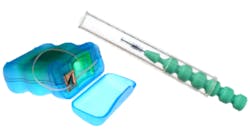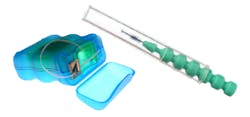Interproximal home care: Your guide to evidence-based recommendations
“It's one of the most universal recommendations in all of public health: Floss daily to prevent gum disease and cavities. Except there's little proof that flossing works.”
—Jeff Donn, Associated Press
Have you lost some credibility in your patients' eyes in light of the August 2016 Associated Press (AP) article addressing the effectiveness of flossing? Have your patients been asking you, "Why bother?" The article brought the need to floss under scrutiny by referring to the updated federal government dietary guidelines wherein flossing was eliminated. (1) While it is true that, due to many factors, research is weak about the effectiveness of flossing, it does not change what we know all too well from our professional experiences with patients. Thanks to the AP, we have an opportunity to revisit the topic.
As oral care providers we have a pretty good handle on the needto maintain interdental health and how neglect can cause its decline, leading to gingivitis, periodontitis, and eventual tooth loss. Although dental professionals often recommend flossing, flossing is not always the best choice for all patients. Regular disruption of bacteria with an emphasis on gingival stimulation can go a long way in maintaining gingival health. As oral health-care specialists, we have the opportunity to change the conversation with our patients from the focus on flossing daily to the need for regular interdental stimulation, plaque removal, and bacterial disruption. The question is: What is the best choice for each patient?
The interproximal home-care product market is larger than one might imagine. Beyond floss, there are air and water flossers, proxy brushes, interdental picks and tips of all sorts, and even mouth rinses that claim to remove plaque. With this large market, our patients can be confused about what they should be using and what is effective. So, what are the choices today and what does the research say about them?
Proximal brushes: Conical or cone?
Because our patients present with a variety of papillae shapes, adding an interdental brush to a home-care routine could be needed for keeping the interproximal area clean. In a 2016 study published in the International Journal of Dental Hygiene, researchers sought to determine the effectiveness of the two different shapes of interdental brushes commonly recommended for patients: cylindrical and conical. (2) The results of this investigation found that, when study participants used conical interdental brushes, the plaque and bleeding scores were higher when compared to the baseline at lingual sites. (2) In other words, when compared to cylindrical interdental brushes, the conical interdental brushes were found to be less effective. For patients who have periodontal concerns with open interdental areas, adding a cylindrical brush, rather than a cone-shaped interdental brush, can be more effective in reducing the amount of plaque and bleeding. (2)
Air flossing, water flossing, or irrigation?
Oral irrigation is often recommended for patients with orthodontics or patients with periodontal disease. Several studies have been conducted to determine the effectiveness of home oral irrigation.
A study published in the Journal of Clinical Dentistry found that oral irrigation can be effective at reducing bleeding, reducing inflammation, and removing plaque. (3) Overall, the study found that combining oral irrigation with brushing can be more effective at reducing plaque, bleeding, and inflammation when compared to manual brushing and flossing alone. (3)
In a 2015 study, investigators compared the use of a Waterpik Water Flosser and the use Sonicare Air Floss Pro, using bleeding on probing, the Modified Gingival Index, and the Navy Plaque Index to determine the effectiveness of the products used. (4) The results of the study concluded that the Waterpik Water Flosser is more effective when compared to the Sonicare Air Floss Pro. (4) Water flossers provide patients with an acceptable and easy alternative to traditional methods, and water flossing can be very useful for periodontal pocketing, orthodontics, the elderly, and those with arthritis or limited dexterity.
Floss: Waxed, unwaxed, woven, or tape?
Dental floss variations can also be confusing for our patients. Should they use waxed or unwaxed floss, woven floss or a shred-resistant tape? This too has been investigated by researchers who have concluded, once again, that individual patient preferences and circumstances will dictate the best choice for each individual. While “an unsubstantiated belief in the superiority of unwaxed floss has persisted to the present time,” studies have demonstrated that patient preferences favor the waxed variety. (5) In a study involving dental hygiene students, four different types of floss—waxed, unwaxed, woven, and shred-resistant—were evaluated for plaque removal, ease of use, and comfort. (6) Although these subjects were considered to have normal dentitions, thus limiting the research, the results showed that the greatest reduction in total interproximal plaque scores was achieved using waxed floss. (6)
The gold-standard comparison
Another investigation compared the plaque-removing capabilities of three different interdental products with dental floss. 120 subjects with suitable interproximal sites were screened for the six-week long study, and participants were randomly assigned to one of four products: Glide dental floss (Oral-B), Butler flossers (Sunstar), Gum Go-Betweens Proxabrush cleaners (Sunstar), and Gum Soft-Picks (Sunstar). (7)
To increase to accuracy of the results, three indices were used in this study: the Plaque, Gingivitis, and Eastman Interdental Bleeding Indices. (7) The results showed that all of the products involved in the study significantly reduced interdental plaque; however, despite being considered the "gold standard" for gingivitis reduction, the dental floss in this study was "matched in performance" by the flossers and the Soft-Picks. (7) Furthermore, "the Go-Betweens cleaners showed a statistically greater reduction in the Gingival Index score buccally than the other three products.” (7)
The dental product market is vast and includes well-known and not-so-well-known companies. There are many home-care products for interproximal care to target just about any patient’s individual preferences and needs. Much of the research available to address this question of interproximal care is subject to bias and limitations, and suggestions and conclusions provided here are no exception.
However, dental professionals are often the ones patients look to for clarity in product selection, demonstrating the importance of staying up to date about what is available and what the research shows. Knowledge of patients’ needs and attitudes about flossing, coupled with clinical experience, can help dental professionals guide patients to select products that are evidence-based, effective, and acceptable to the patient. Now, with thanks to the AP, let’s take the opportunity to discuss interproximal health with our patients once again.
Editor's note: This article first appeared in Pearls for Your Practice: The Hygiene Product Navigator. Click here to subscribe. Click here to submit a products article for consideration.
References
1. Donn J. Medical benefits of dental floss unproven. Associated Press News. http://bigstory.ap.org/article/f7e66079d9ba4b4985d7af350619a9e3/medical-benefits-dental-floss-unproven. Published August 2, 2016. Accessed August 2, 2016.
2. Larsen HC, Slot DE, Van Zoelen C, Barendregt DS, Van der Weijden GA. The effectiveness of conically shaped compared with cylindrically shaped interdental brushes - a randomized controlled clinical trial [published online January 11, 2016]. Int J Dent Hyg. doi: 10.1111/idh.12189.
3. Barnes CM, Russell CM, Reinhardt RA, Payne JB, Lyle DM. Comparison of irrigation to floss as an adjunct to tooth brushing: Effect on bleeding, gingivitis, and supragingival plaque. J Clin Dent. 2005;16(3):71-77.
4. Goyal CR, Lyle DM, Qaqish JG, Schuller R. Efficacy of two interdental cleaning devices on clinical signs of inflammation: A four-week randomized controlled trial. J Clin Dent. 2015;26(2):55-60.
5. Beaumont RH. Patient preference for waxed or unwaxed dental floss. J Periodontol. 1990;61(2):123-125.
6. Carr MP, Rice GL, Horton JE. Evaluation of floss types for interproximal plaque removal. Am J Dent. 2003;13(4):212-214.
7. Yost KG, Mallatt ME, Liebman J. Interproximal gingivitis and plaque reduction by four interdental products. J ClinDent. 2006;17(3):79-83.
More reading:
For patients who will never be flossers, what can you do? A whole lot
Alternatives to floss: A review of Sunstar's Soft-Picks Advanced
Alternatives to floss: A review of the TePe Interdental Brush Kit



